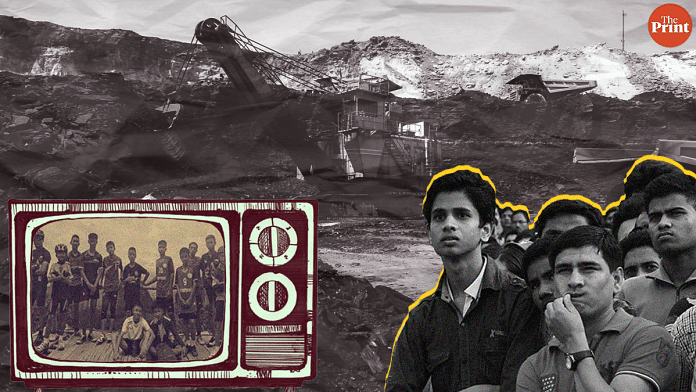Rescue workers have been trying to reach the coal miners trapped in east Jaintia Hills of Meghalaya since 13 December. The rescue team has been requesting sophisticated equipment including high power pumps for faster rescue. In June this year, the Thai rescue operation garnered worldwide attention after Thai boys and their football coach were trapped in a cave for weeks.
ThePrint asks: Indians prayed for Thai cave rescue, but why no outrage for Meghalaya’s trapped miners?
No one cares about northeast because their weight in national politics is negligible
 Patricia Mukhim
Patricia Mukhim
Editor, The Shillong Times
The mines in Meghalaya are privately owned and there is no mining policy governing them. The national mining policy isn’t applicable here either because of the Sixth Schedule. So, the mining sector has virtually become free for all.
This isn’t the first time such an incident has occurred. It happened in 1992 when 30 miners were trapped in Garo hills, and it happened again in 2012—but they were hardly paid any attention.
The Thai boys who were trapped in a cave a few months back received enormous worldwide attention. But India doesn’t seem to have the same kind of concern when something similar happens in its own territory.
We must also look at the kind of response that has come from the district administration of the Jaintia Hills. They seemed to be more concerned about covering up their tracks, because they too have been in denial about illegal mining, instead of seeking help from other quarters for the rescue operation.
The media is also to be held responsible. There is such elaborate coverage of politics of mainland India, but no one seems to care about Meghalaya. This is because the northeast collectively contributes only 26 MPs, and they don’t carry much weight. Even in the ongoing parliamentary session, no one has raised a zero hour motion on this life and death matter.
We don’t even know if more such incidents have taken place in Meghalaya
 Justice B.P. Katoki (Retd)
Justice B.P. Katoki (Retd)
Head, NGT-appointed panel studying the impact of rat-hole mining
In 2014, the NGT completely banned rat-hole coal-mining activity as well as the transportation of coal from the state of Meghalaya to other states.
Despite this, the transportation continues unrestricted. It is the responsibility of the state government to implement the ban, but they have failed to do so.
As a result of this negligence, 13 miners are trapped in the Jaintia Hills today. The sad bit is that the number may even be more than 13, but we can’t even be sure of that. Moreover, we don’t even know if more such incidents have taken place in the past, but never got the attention they deserved.
Even the mine owners who own land legally, have to gain permission from the environment authority. No permission has been taken in Meghalaya by most of the mine owners. The ill-effects of such unauthorised coal mining are enormous, and well-documented.
I am not against the idea of coal mining in itself. If the mining authorities comply with the environmental regulations, then such a problem would never arise.
We can definitely prevent such an incident from occurring again, but sufficient resources and forces to implement this ban must be provided to the Meghalaya government. Illegal coal-mining is rampant in the most remote areas of Meghalaya, so the ban is near impossible to implement without the required forces.
We rescuers referred to a foul odour, and the media assumed that all the miners were dead
 Santosh Singh
Santosh Singh
Assistant commandant, NDRF
As someone who is heading the rescue operation of the trapped miners, I cannot ever give up hope. We are waiting for the water levels to recede and will stay on ground till there is even an iota of hope left.
We referred to a certain ‘foul odour’ coming from the caves, and media reports carried it as being indicative of the miners’ death, but that is jumping the gun. The water may have gone stale and that may be the source of the foul odour. As a rescuer, I would never so casually imply that those we are out to rescue are no more. Why would we continue to be on field if that was the case?
I would also like to clarify that the NDRF never asked for high power pumps. It is the mining experts who came to visit the site of the rescue operation and suggested to the district administration that high power pumps must be provided.
As far as the NDRF is concerned, we are being provided whatever help and aid we are asking for. That said, people need to understand that I can’t put the life of my rescue team at risk either. Their lives are as important and I am not willing to compromise their lives.
Indian manufactured pumps were used for Thai cave operation, surely they can be used again
 Ambuj Sharma
Ambuj Sharma
Secretary General, NHRC
The state human rights commission had taken cognisance of the matter as soon as was possible. As far as the rescue operation is concerned, the district administration will not leave any stone unturned to rescue the miners.
There has been a lot of talk of whether or not high power pumps have been put in place. The district administration, I am certain, are ensuring that the requirements are being met. I believe in the case of the Thai boys trapped in the cave, it was the Kirloskar manufactured pumps that were used—i.e pumps of an Indian company. I am sure they can be contacted, and should be contacted for their aid.
The Supreme Court banned rathole mining years back. But evidence of coal mining occurring illegally in remote regions of Meghalaya is coming to the fore. In fact, there are also chances of trafficking of kids from UP and Bihar to work as miners in these illegal firms, which is horrible.
State government must ensure illegal mining is put an end to immediately. But whoever has employed these miners who find themselves trapped today, must also be taken to task. At the end of the day, this is illegal and the employers of these miners must be penalised for this.
Even if the mine was illegal, should the miners be just left behind to die?
 Moushumi Das Gupta
Moushumi Das Gupta
Senior associate editor, ThePrint
It is not the first time that news related to the northeast, especially one that involves poor people in the back of beyond East Jaintia Hills, has fallen off the nation’s radar.
It’s been 14 days since the 15 miners got trapped inside an illegal rathole mine that got flooded in Ksan village in East Jaintia Hills. The chances of these men coming out alive from inside the 250 feet deep pit filled with cold water are almost negligible.
But nobody, least of all the state government, is bothered. Till now, the National Disaster Response Force has not been able to locate one survivor or retrieve any bodies. Reason: The equipment provided by the administration is inadequate for the complex operation.
The state has failed to respond to the district administration’s repeated request to provide more men and powerful machines. Maybe, the men could have been saved if help had come on time.
One reason for the state to shy away from its responsibility could be that they don’t want to acknowledge the fact that mining is continuing rampantly despite the ban. Also, the fact that the mine was running illegally speaks volume about the nexus between illegal mine owners, administration and politicians. Second, the victims come from poor families with nobody to take up their cause. With authorities refusing to budge, families are clueless as to who should they approach.
The families are asking a very legitimate question: Even if the mine was illegal, should the miners be just left behind to die. The least the government can do is to help retrieve the bodies of their loved ones and give them closure. Is it too much to ask for?
By Fatima Khan and Moushumi Das Gupta.






